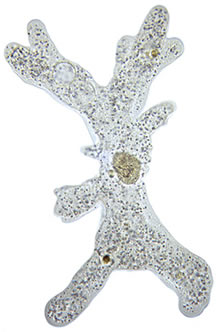The movements of amoeba are based on the actin cytoskeleton (background here).
Actin filaments are composed of the protein actin and a number of accessory proteins.
Actin filaments are dynamic; they can be growing (polymerizing) or shrinking (depolymerizing) within different regions of the same cell.
Whether the actin filaments in a particular region of a cell are growing or shrinking depends on the activity of various actin-binding proteins.
Some actin-binding proteins act to cross-link actin filaments together into parallel bundles or loose networks.
Networks of filaments form a gel, which can be quite stiff.
<- roll over

